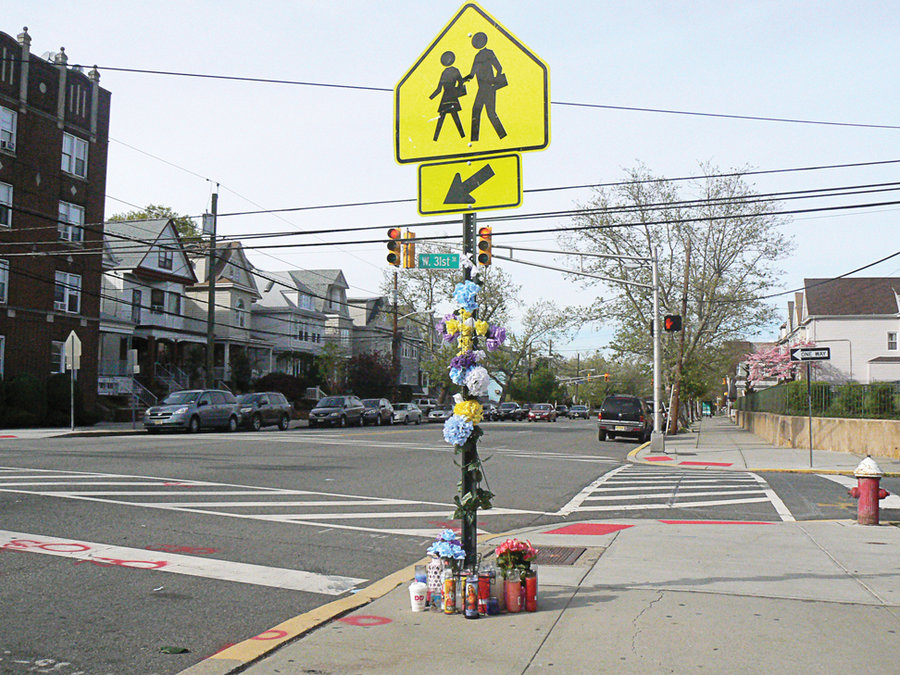David Porto, 43, of Jersey City, was fatally struck by a northbound Ford F-350 pickup truck on Kennedy Blvd. in Bayonne between 30th and 31st streets on Wednesday afternoon, April 27. while trying to enter his parked Nissan wagon, according to a statement from the Bayonne Police Department. Porto was pronounced dead at the scene. The truck then hit the rear of a parked car, which in turn damaged two vehicles parked in front of that car. The incident is still under investigation.The identity of the driver has not been released, nor has the driver been charged.
One resident who lives a few doors down said the victim “was leaving the doctor’s office right there, went to get in his car, and he got hit.” There was confusion at first as to what happened. “I saw a black Jeep run down and stop another guy thinking it was a hit-and-run. Then [Porto] was already dead.It’s very unfortunate.”
Last week’s incident is one in a long string of fatalities on Kennedy Blvd. across the county. Two teens were killed in early March by a vehicle that jumped the curb of that road near the North Bergen/Union City border. That area is near Route 495 approaching the Turnpike, and the speed limit is 25 miles per hour. The driver allegedly was going 74 miles per hour.
Later that same month, a 5-year-old boy was struck by an SUV in Bayonne, causing minor injuries. On March 9, a woman was struck by car while crossing the Boulevard in Jersey City.
One mile-long section in Jersey City, between Fairmount Avenue and Newark Avenue, has been ranked the most dangerous stretch of road in Hudson County by the New Jersey Transportation Planning Authority (NJTPA), which oversees, studies, and funds safety and transportation improvement projects.
Reoccurring trend?
To address safety issues, the Hudson County Prosecutor’s Office announced “Operation Slow Down, and Save Lives” in April. The program will place heavier enforcement on speeding, yielding to pedestrians, and jaywalking, according to an announcement from the prosecutor’s office. Local police departments will work with the prosecutor’s office and the Hudson County Sheriff’s Office to implement the program, which will continue into the summer.
“The Bayonne section of J.F.K. Boulevard is a part of an overall safety study that is underway.” — Jim Kennelly
____________
Hudson Boulevard
“Kennedy Boulevard is an old road,” said North Bergen Mayor Nicholas Sacco recently. “It was a road that was made for horses, wagons,” and it winds along the cliffs.
He added, “At that point it was safe. Today it’s a road that has a lot of turns and would not be built the way it is now if things could be done all over again.”
In 1873, the New York Times chronicled the building of “Hudson Boulevard,” now Kennedy Blvd.
The state commissioned a board to oversee the construction of a “boulevard as fine as the view it would command” that would stretch from Bergen Point to the Palisades. It proved to be popular, especially among those whose properties increased in value after the construction. The Times wrote, “There were no objections to the scheme itself, but objections to the line and the width – which the Commissioners proposed to fix at 150 feet.”
Nowadays, the wider roads lead to faster driving. They also take longer for pedestrians to cross, putting them at risk.
After the accident
After the accident, Hudson County Sheriff Frank X. Schillari said in a statement, “The safety of pedestrians and drivers throughout Hudson County is one of my top priorities … We are urging drivers to slow down throughout the county, especially on Kennedy Boulevard … In Operation Slow Down, Save Lives, we also ask that pedestrians be careful by using designated crosswalks, obeying crossing lights and looking out for oncoming traffic. Educating Hudson County residents on pedestrian and driver safety is of the utmost urgency for our residents’ well-being.”
The Bayonne Police Department is doing what it can help improve traffic safety. It can control how much it enforces traffic laws on J.F.K., but not the Boulevard itself. The county is planning to improve intersections and better plan for pedestrian safety. These are all necessary steps to reduce the risk of more pedestrian fatalities, but they cannot fix a problem that has been irking taxpayers for a century and a half – road width.
